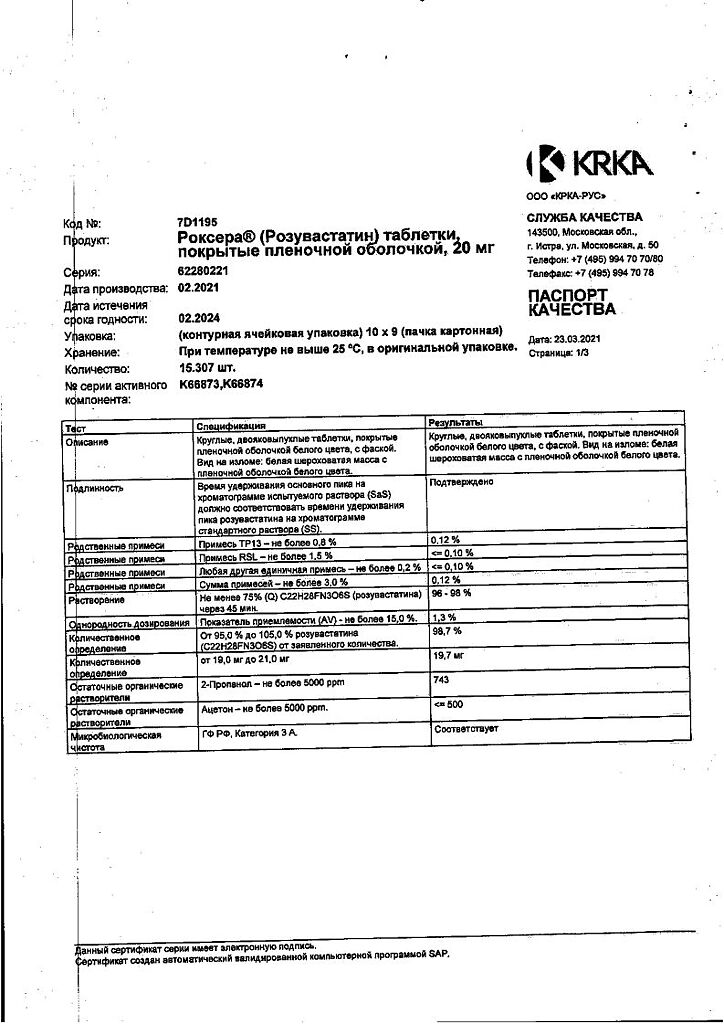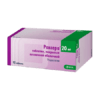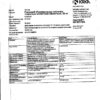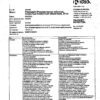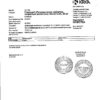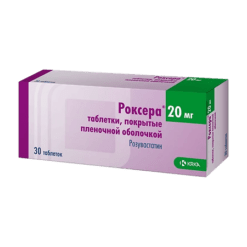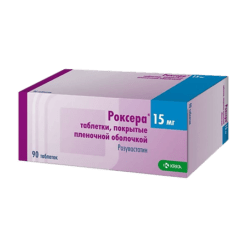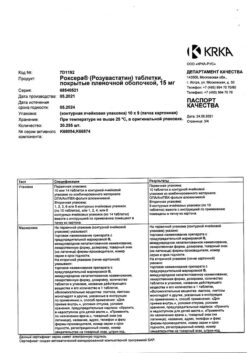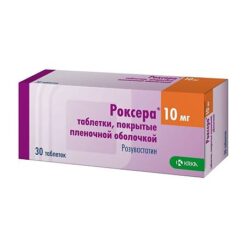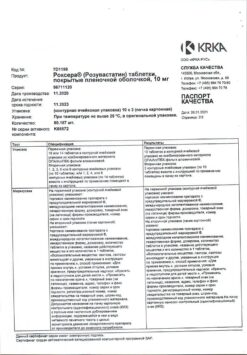No products in the cart.
Roxera, 20 mg 90 pcs.
€68.38 €56.99
Description
Primary hypercholesterolemia according to Fredrickson classification (type IIa, including familial heterozygous hypercholesterolemia) or mixed hypercholesterolemia (type IIb) – as an addition to diet when diet and other nonmedicamental methods of treatment (for example, physical exercises, weight reduction) are insufficient.
– familial homozygous hypercholesterolemia – as an adjunct to diet and other lipid-lowering therapy (e.g., LDL-apheresis) or in cases when such therapy is not sufficiently effective.
– Hypertriglyceridemia (type IV by Fredrickson classification) – as a dietary supplement.
– To slow the progression of atherosclerosis – as a supplement to diet in patients who are indicated for therapy to reduce plasma concentration of total CHD and LDL-C.
– Primary prevention of major cardiovascular complications (stroke, myocardial infarction, arterial revascularization) in adult patients without clinical signs of CHD, but with an increased risk of its development (age over 50 years for men and over 60 years for women, increased plasma concentration of C-reactive protein [≥ 2 mg/L] in the presence of at least one additional risk factor, such as arterial hypertension, low plasma concentration of HDL-C, smoking, family history of early-onset CHD).
Indications
Indications
Fredrickson primary hypercholesterolemia (type IIa, including familial heterozygous hypercholesterolemia) or mixed hypercholesterolemia (type IIb) – as an adjunct to diet when diet and other non-drug treatments (eg, exercise, weight loss) are insufficient.
· Familial homozygous hypercholesterolemia – as an adjunct to diet and other lipid-lowering therapy (eg, LDL apheresis) or in cases where such therapy is not sufficiently effective.
· Hypertriglyceridemia (type IV according to the Fredrickson classification) – as an addition to the diet.
· To slow the progression of atherosclerosis – as an addition to the diet in patients who are indicated for therapy to reduce the plasma concentration of total cholesterol and LDL-cholesterol.
Primary prevention of major cardiovascular complications (stroke, myocardial infarction, arterial revascularization) in adult patients without clinical signs of coronary artery disease, but with an increased risk of its development (age over 50 years for men and over 60 years for women, increased plasma concentration of C-reactive protein [≥ 2 mg/l] in the presence of at least one of the additional risk factors, such as arterial hypertension, low plasma concentration HDL-C, smoking, family history of early onset CAD).
Pharmacological effect
Pharmacological effect
lipid-lowering agent – HMG-CoA reductase inhibitor
Special instructions
Special instructions
At a daily dose of up to 30 mg
There is a risk of developing myopathy/rhabdomyolysis – renal failure, hypothyroidism, a history of hereditary muscle diseases (including family history) and a previous history of muscle toxicity when using other HMG-CoA reductase inhibitors or fibrates; excessive alcohol consumption; age over 65 years; conditions in which an increase in plasma concentration of rosuvastatin is noted; race (Mongoloid race – Japanese and Chinese); simultaneous use with fibrates; history of liver disease; sepsis; arterial hypotension; extensive surgical interventions; injuries; severe metabolic, endocrine or electrolyte disturbances; uncontrollable seizures; simultaneous use with ezetimibe.
At a daily dose of 30 mg or more
Mild renal failure (creatinine clearance more than 60 ml/min); age over 65 years; history of liver disease; sepsis; arterial hypotension; extensive surgical interventions; injuries; severe metabolic, endocrine or electrolyte disturbances; uncontrollable seizures; simultaneous use with ezetimibe.
Contraindicated for persons under 18 years of age.
Patients with kidney failure
In patients with mild or moderate renal impairment, no dose adjustment is required. In patients with severe renal failure (creatinine clearance less than 30 ml/min), the use of Roxera® is contraindicated. The use of Roxera® in a dose of more than 30 mg/day in patients with moderate to severe renal failure (creatinine clearance less than 60 ml/min) is contraindicated. For patients with moderate renal failure, the recommended initial dose of Roxera® is 5 mg/day.
Patients with liver failure
Roxera® is contraindicated in patients with active liver disease.
Use in elderly patients
No dose adjustment required.
Renal dysfunction
In patients receiving high doses of rosuvastatin (particularly 40 mg/day), tubular proteinuria was observed, which was detected using test strips and in most cases was intermittent or short-term. Such proteinuria does not indicate acute illness or progression of concomitant renal disease. The incidence of serious renal dysfunction observed in post-marketing studies of rosuvastatin is higher when taking a dose of 40 mg/day. In patients taking Roxera® at a dose of 30 or 40 mg/day, it is recommended to monitor kidney function indicators during treatment (at least once every 3 months).
Effect on the musculoskeletal system
The following musculoskeletal effects have been reported with rosuvastatin at all doses, but particularly at doses greater than 20 mg/day: myalgia, myopathy, and in rare cases, rhabdomyolysis. Very rare cases of rhabdomyolysis have been reported with the simultaneous use of HMG-CoA reductase inhibitors and ezetimibe. This combination should be used with caution, as pharmacodynamic interactions cannot be excluded.
As with other HMG-CoA reductase inhibitors, the incidence of rhabdomyolysis with post-marketing use of rosuvastatin is higher when using a dose of 40 mg/day.
Determination of serum CPK activity
Serum CPK activity cannot be determined after intense physical exercise and in the presence of other possible reasons for an increase in its activity; this may lead to incorrect interpretation of the results obtained. If the initial serum CPK activity is significantly exceeded (5 times higher than the upper limit of normal), a repeat analysis should be performed after 5-7 days. Therapy should not be started if the results of a repeat analysis confirm the initial high serum CPK activity (more than 5 times the upper limit of normal).
Before starting therapy
Depending on the daily dose, Roxera® should be administered with caution to patients with existing risk factors for myopathy/rhabdomyolysis.
These factors include:
renal dysfunction,
hypothyroidism,
history of muscle diseases (including family history),
history of myotoxic effects when taking other HMG-CoA reductase inhibitors or fibrates,
excessive alcohol consumption,
age over 65 years,
conditions in which the concentration of rosuvastatin in the blood plasma may increase,
simultaneous use of fibrates.
In such patients, it is necessary to evaluate the risks and possible benefits of therapy. Clinical monitoring is also recommended. If the initial serum CPK activity is more than 5 times higher than the upper limit of normal, therapy with Roxera® cannot be started.
During drug therapy
The patient should be informed to immediately report to the doctor if muscle pain, muscle weakness or spasms occur unexpectedly, especially in combination with malaise and fever. In such patients, serum CPK activity should be determined. Therapy should be discontinued if serum CPK activity is significantly increased (more than 5 times the upper limit of normal), or if muscle symptoms are severe and cause daily discomfort (even if serum CPK activity is no more than 5 times the upper limit of normal). If symptoms disappear and serum CPK activity returns to normal, resumption of use of Roxera® or other HMG-CoA reductase inhibitors in lower doses should be considered with careful medical supervision. Monitoring serum CPK activity in the absence of symptoms is impractical.
Very rare cases of immune-mediated necrotizing myopathy have been reported with clinical manifestations in the form of persistent weakness of the proximal muscles and increased CPK activity in the blood serum during therapy or upon discontinuation of the use of HMG-CoA reductase inhibitors, including rosuvastatin. Additional studies of the muscular and nervous system, serological studies, and therapy with immunosuppressive drugs may be required.
There were no signs of increased effects on skeletal muscles when taking rosuvastatin and concomitant therapy. However, an increase in the incidence of myositis and myopathy has been reported in patients taking other HMG-CoA reductase inhibitors in combination with fibric acid derivatives (for example, gemfibrozil), cyclosporine, nicotinic acid in lipid-lowering doses (more than 1 g / day), azole antifungals, HIV protease inhibitors and macrolide antibiotics.
When used simultaneously with certain HMG-CoA reductase inhibitors, gemfibrozil increases the risk of developing myopathy. Thus, the simultaneous use of Roxera® and gemfibrozil is not recommended. The benefits of further changes in plasma lipid concentrations with the combined use of Roxera® with fibrates or nicotinic acid in lipid-lowering doses must be carefully weighed taking into account the possible risks. Roxera® at a dose of 30 mg/day is contraindicated for combination therapy with fibrates.
Roxera® should not be used simultaneously or within 7 days after stopping therapy with systemic fusidic acid preparations. In patients in whom the use of fusidic acid is considered necessary, statin therapy should be discontinued for the entire duration of fusidic acid therapy. There have been reports of rhabdomyolysis (including death in some cases) in patients receiving fusidic acid concomitantly with statins. The patient should seek immediate medical attention if any symptoms of muscle weakness, pain, or tenderness occur.
Therapy with Roxera® can be resumed 7 days after the last dose of fusidic acid.
In exceptional cases, when long-term use of systemic fusidic acid is required, for example, in the treatment of severe infections, the need for simultaneous use of Roxera® and fusidic acid should be considered individually and subject to careful medical supervision.
Due to the increased risk of rhabdomyolysis, Roxera® should not be used in patients with acute conditions that may lead to myopathy or conditions predisposing to the development of renal failure (for example, sepsis, hypotension, major surgery, trauma, severe metabolic, endocrine or electrolyte disturbances, uncontrolled seizures).
2-4 weeks after the start of treatment and/or when increasing the dose of Roxera®, monitoring of lipid metabolism parameters is necessary (dose adjustment is required if necessary).
Liver
Depending on the daily dose, Roxera® should be used with caution in patients with excessive alcohol consumption and/or in patients with a history of liver disease, or its use is contraindicated (see sections “Contraindications” and “With caution”).
It is recommended to determine liver function tests before the start of therapy and 3 months after its start. The use of Roxera® should be discontinued or the dose of the drug should be reduced if the activity of “liver” transaminases in the blood serum is 3 times higher than the upper limit of normal.
In patients with hypercholesterolemia due to hypothyroidism or nephrotic syndrome, treatment of underlying diseases should be carried out before starting treatment with Roxera®.
Ethnic characteristics
During pharmacokinetic studies, an increase in the plasma concentration of rosuvastatin was noted in representatives of the Mongoloid race compared to representatives of the Caucasian race.
Interstitial lung disease
Isolated cases of interstitial lung disease have been reported with the use of certain HMG-CoA reductase inhibitors, especially over long periods of time. Manifestations of the disease may include shortness of breath, non-productive cough and deterioration in general health (weakness, weight loss and fever).
If interstitial lung disease is suspected, therapy with HMG-CoA reductase inhibitors should be discontinued.
Diabetes mellitus type 2
In patients with glucose concentrations between 5.6 and 6.9 mmol/L, rosuvastatin therapy was associated with an increased risk of developing type 2 diabetes mellitus.
HIV protease inhibitors
Concomitant use of the drug with HIV protease inhibitors is not recommended (see section “Interaction with other drugs”).
Special information on excipients
Roxera® contains lactose and is therefore contraindicated in patients with lactose intolerance, lactase deficiency, and glucose-galactose malabsorption syndrome.
Studies have not been conducted to study the effect of rosuvastatin on the ability to drive vehicles and operate machinery. However, given the possibility of developing dizziness and other adverse events, caution must be exercised when driving vehicles and other mechanisms that require increased concentration and speed of psychomotor reactions.
Active ingredient
Active ingredient
Rosuvastatin
Composition
Composition
1 film-coated tablet, 5 mg/10 mg/15 mg/20 mg/30 mg/40 mg contains:
Core:
Active ingredient:
Rosuvastatin calcium 5.21 mg/10.42 mg/15.62 mg/20.83 mg/31.25 mg/41.66 mg, equivalent to rosuvastatin 5.00 mg/10.00 mg/15.00 mg/20.00 mg/30.00 mg/40.00 mg
Excipients:
Microcrystalline cellulose, lactose, crospovidone, colloidal silicon dioxide, magnesium stearate
Film shell:
Butyl methacrylate, dimethylaminoethyl methacrylate and methyl methacrylate copolymer [1:2:1], macrogol-6000, titanium dioxide, lactose monohydrate
Pregnancy
Pregnancy
Roxera® is contraindicated during pregnancy and breastfeeding.
Women of reproductive age should use adequate methods of contraception.
Since cholesterol and substances synthesized from cholesterol are important for the development of the fetus, the potential risk of inhibiting HMG-CoA reductase for the fetus outweighs the benefit of using the drug during pregnancy for the mother.
If pregnancy occurs during therapy, use of the drug should be discontinued immediately.
There are no data regarding the penetration of rosuvastatin into breast milk (it is known that other HMG-CoA reductase inhibitors can pass into breast milk), therefore the use of the drug must be discontinued during breastfeeding.
Contraindications
Contraindications
Hypersensitivity to rosuvastatin and/or any of the excipients in the drug;
liver diseases in the active phase (including a persistent increase in the activity of “liver” transaminases and an increase in the activity of “liver” transaminases in the blood serum by more than 3 times compared with the upper limit of normal);
moderate to severe renal failure (creatinine clearance less than 60 ml/min);
myopathy;
simultaneous use of cyclosporine;
patients predisposed to the development of myotoxic complications;
pregnancy, breastfeeding period;
use in women with preserved reproductive potential who do not use adequate methods of contraception;
hypothyroidism;
history of muscle diseases (including family history);
history of myotoxicity with the use of other HMG-CoA reductase inhibitors or fibrates;
excessive alcohol consumption;
conditions that can lead to increased concentrations of rosuvastatin in blood plasma;
simultaneous use of fibrates;
lactose intolerance, lactase deficiency, glucose-galactose malabsorption syndrome;
patients of the Mongoloid race;
age up to 18 years.
Side Effects
Side Effects
AEs observed with the use of rosuvastatin are usually mild and resolve on their own. As with the use of other HMG-CoA reductase inhibitors, the incidence of AEs is mainly dose-dependent.
Classification of the incidence of AEs recommended by the World Health Organization (WHO):
very common ≥ 1/10
often ≥ 1/100 to < 1/10
uncommon ≥ 1/1000 to < 1/100
rarely from ≥ 1/10000 to < 1/1000
very rare <1/10000
frequency unknown cannot be estimated from available data.
Blood and lymphatic system disorders
frequency unknown: thrombocytopenia.
Immune system disorders
rarely: hypersensitivity reactions, including angioedema.
Endocrine system disorders
often: type 2 diabetes mellitus.
Nervous system disorders
often: headache, dizziness;
very rarely: loss or decrease in memory;
frequency unknown: peripheral neuropathy.
Respiratory, thoracic and mediastinal disorders
frequency unknown: cough, shortness of breath.
Gastrointestinal disorders
often: constipation, nausea, abdominal pain;
rarely: pancreatitis;
very rarely: jaundice, hepatitis;
frequency unknown: diarrhea.
When using rosuvastatin, a dose-dependent increase in the activity of “liver” transaminases in the blood plasma is observed in a small number of patients. In most cases it is minor, asymptomatic and temporary.
Skin and subcutaneous tissue disorders
uncommon: skin itching, skin rash, urticaria;
frequency unknown: Stevens-Johnson syndrome.
Musculoskeletal and connective tissue disorders
often: myalgia;
rarely: myopathy (including myositis), rhabdomyolysis (with or without acute renal failure);
very rarely: arthralgia;
frequency unknown: immune-mediated necrotizing myopathy.
A dose-dependent increase in creatine phosphokinase (CPK) activity in blood plasma is observed in a small number of patients taking rosuvastatin. In most cases it is minor, asymptomatic and temporary. If CPK activity in the blood plasma increases to more than 5 times the upper limit of normal, therapy should be suspended.
Renal and urinary tract disorders
very rare: hematuria.
Proteinuria may be detected in patients receiving rosuvastatin therapy. A change in the amount of protein in the urine (from none or trace amounts to ++ or more) occurs in less than 1% of patients receiving 10-20 mg rosuvastatin and in approximately 3% of patients receiving 40 mg rosuvastatin. A slight change in the amount of protein in the urine was noted when taking a dose of 20 mg. In most cases, proteinuria decreases or disappears during therapy and does not indicate the onset of acute or progression of existing kidney disease.
Disorders of the genital organs and breast
frequency unknown: gynecomastia.
General and administration site disorders
often: asthenic syndrome;
frequency unknown: peripheral edema.
Laboratory and instrumental data
When using rosuvastatin, the following changes in laboratory parameters were also observed: hyperglycemia, increased concentration of bilirubin in the blood plasma, activity of gamma-glutamyl transpeptidase, alkaline phosphatase in the blood plasma, changes in the serum concentration of thyroid hormones.
The following AEs have been reported with the use of certain HMG-CoA reductase inhibitors (statins): depression, sleep disorders, including insomnia and nightmares, sexual dysfunction, increased concentration of glycated hemoglobin in the blood. Isolated cases of interstitial lung disease have been reported, especially with long-term use of drugs (see section “Special instructions”).
Interaction
Interaction
The effect of the use of other drugs on rosuvastatin
Transport protein inhibitors
Rosuvastatin is a substrate for some transport proteins, in particular OATP1B1 and BCRP. The simultaneous use of drugs that are inhibitors of these transport proteins may be accompanied by an increase in the concentration of rosuvastatin in the blood plasma and an increased risk of developing myopathy (see sections “Dosage and Administration”, “Special Instructions” and Table 3).
Cyclosporine
With simultaneous use of rosuvastatin and cyclosporine, the AUC of rosuvastatin is on average 7 times higher than the value observed in healthy volunteers (see Table 3). Concomitant use with rosuvastatin does not affect the concentration of cyclosporine in the blood plasma. The use of rosuvastatin is contraindicated in patients taking cyclosporine (see section “Contraindications”).
HIV protease inhibitors
Concomitant use of HIV protease inhibitors may significantly increase the exposure of rosuvastatin (see Table 3). The simultaneous use of 20 mg of rosuvastatin and a combination of two HIV protease inhibitors (400 mg of lopinavir/100 mg of ritonavir) is accompanied by an increase in the equilibrium AUC (0-24 hours) and Cmax of rosuvastatin by 2 and 5 times, respectively. Therefore, simultaneous use of rosuvastatin and HIV protease inhibitors is not recommended (see section “Dosage and Administration” and Table 3).
Gemfibrozil and other lipid-lowering drugs
The simultaneous use of rosuvastatin and gemfibrozil leads to a 2-fold increase in the Cmax and AUC of rosuvastatin in the blood plasma (see section “Special Instructions”). Based on specific interaction data, a pharmacokinetically significant interaction with fenofibrate is not expected, but a pharmacodynamic interaction is possible. Gemfibrozil, fenofibrate, other fibrates and lipid-lowering doses of nicotinic acid (more than 1 g/day) increased the risk of myopathy when used concomitantly with HMG-CoA reductase inhibitors, possibly due to the fact that they can cause myopathy when used in monotherapy (see section “Special Instructions”). The simultaneous use of fibrates and rosuvastatin in a daily dose of 30 mg is contraindicated. In such patients, therapy should begin with a dose of 5 mg/day (see sections “Contraindications”, “Dosage and Administration”, “Special Instructions”).
Ezetimibe
The simultaneous use of rosuvastatin at a dose of 10 mg and ezetimibe at a dose of 10 mg was accompanied by an increase in the AUC of rosuvastatin in patients with hypercholesterolemia (see Table 3). A pharmacodynamic interaction between rosuvastatin and ezetimibe, manifested by an increased risk of adverse reactions, cannot be excluded.
Antacids
The simultaneous use of rosuvastatin and antacids containing aluminum and/or magnesium hydroxide leads to a decrease in the plasma concentration of rosuvastatin by approximately 50%. This effect is less pronounced if antacids are used 2 hours after taking rosuvastatin. The clinical significance of this interaction has not been studied.
Erythromycin
The simultaneous use of rosuvastatin and erythromycin leads to a decrease in AUC(0-t) of rosuvastatin by 20% and its Cmax by 30%. This interaction may occur as a result of increased intestinal motility caused by the use of erythromycin.
Isoenzymes of the cytochrome P450 system
The results of studies conducted in vivo and in vitro showed that rosuvastatin is neither an inhibitor nor an inducer of isoenzymes of the cytochrome P450 system. In addition, rosuvastatin is a weak substrate for this isoenzyme system. Therefore, interaction of rosuvastatin with other drugs at the metabolic level involving isoenzymes of the cytochrome P450 system is not expected.
No clinically significant interaction was observed between rosuvastatin and fluconazole (an inhibitor of CYP2C9 and CYP3A4 isoenzymes) and ketoconazole (an inhibitor of CYP2A6 and CYP3A4 isoenzymes).
Interactions with drugs that require dose adjustment of rosuvastatin (see Table 3)
The dose of Roxera® should be adjusted if it is necessary to use it simultaneously with drugs that increase the exposure of rosuvastatin. If exposure is expected to increase by 2 times or more, the initial dose of Roxera® should be 5 mg 1 time per day.
The maximum daily dose of Roxera® should also be adjusted so that the expected exposure to rosuvastatin does not exceed that for a dose of 40 mg taken without the simultaneous administration of drugs that interact with rosuvastatin. For example, the maximum daily dose of Roxera® when used simultaneously with gemfibrozil is 20 mg (increased exposure by 1.9 times), with ritonavir/atazanavir – 10 mg (increased exposure by 3.1 times).
Table 3
Effect of concomitant therapy on rosuvastatin exposure (AUC, data in descending order) – results of published clinical studies
Concomitant therapy regimen
Rosuvastatin dosage regimen
Change in rosuvastatin AUC*
Cyclosporine 75-200 mg 2 times a day, 6 months
10 mg once a day, 10 days
7.1x magnification
Regorafenib 160 mg once daily, 14 days
5 mg once
3.8x magnification
Atazanavir 300 mg/ritonavir 100 mg once daily, 8 days
10 mg once
3.1x magnification
Simeprevir 150 mg once a day, 7 days
10 mg once
2.8x magnification
Velpatasvir 100 mg once daily
10 mg once
2.7 times magnification
Ombitasvir 25 mg/paritaprevir 150 mg/ritonavir 100 mg once daily/dasabuvir 400 mg twice daily, 14 days
5 mg once
2.6x magnification
Grazoprevir 200 mg/elbasvir 50 mg once daily, 11 days
10 mg once
2.3 times magnification
Glecaprevir 400 mg/pibrentasvir 120 mg once daily, 7 days
5 mg once a day, 7 days
2.2 times magnification
Lopinavir 400 mg/ritonavir 100 mg 2 times a day, 17 days
20 mg once a day, 7 days
2.1x magnification
Clopidogrel 300 mg (loading dose), then 75 mg after 24 hours
20 mg once
2x magnification
Gemfibrozil 600 mg 2 times a day, 7 days
80 mg once
1.9x magnification
Eltrombopag 75 mg once daily, 5 days
10 mg once
1.6x magnification
Darunavir 600 mg/ritonavir 100 mg 2 times a day, 7 days
10 mg once a day, 7 days
1.5 times magnification
Tipranavir 500 mg/ritonavir 200 mg 2 times a day, 11 days
10 mg once
1.4x magnification
Dronedarone 400 mg twice daily
No data
1.4x magnification
Itraconazole 200 mg once a day, 5 days
10 mg once
**1.4x increase
Ezetimibe 10 mg once daily, 14 days
10 mg once a day, 14 days
**1.2x increase
Fosamprenavir 700 mg/ritonavir 100 mg twice daily, 8 days
10 mg once
No changes
Aleglitazar 0.3 mg, 7 days
40 mg, 7 days
No changes
Silymarin 140 mg 3 times a day, 5 days
10 mg once
No changes
Fenofibrate 67 mg 3 times a day, 7 days
10 mg, 7 days
No changes
Rifampicin 450 mg once a day, 7 days
20 mg once
No changes
Ketoconazole 200 mg 2 times a day, 7 days
80 mg once
No changes
Fluconazole 200 mg once a day, 11 days
80 mg once
No changes
Erythromycin 500 mg 4 times a day, 7 days
80 mg once
20% reduction
Baikalin 50 mg 3 times a day, 14 days
20 mg once
47% reduction
*Data presented as fold changes represent the simple relationship between concomitant use and use of rosuvastatin alone. Data presented as % changes represent the % difference of coadministration compared with rosuvastatin alone.
**Several studies have been conducted to examine the interaction of different doses of rosuvastatin, the table indicates the most significant change.
The effect of rosuvastatin on other drugs
Vitamin K antagonists
As with other HMG-CoA reductase inhibitors, initiating or increasing the dose of rosuvastatin in patients taking concomitant vitamin K antagonists (eg, warfarin) may result in an increase in the international normalized ratio (INR). Discontinuation of rosuvastatin or reduction in its dose may lead to a decrease in MHO. In such cases, MHO monitoring is recommended.
Oral contraceptives/hormone replacement therapy (HRT)
Concomitant use of rosuvastatin and oral contraceptives increases the AUC of ethinyl estradiol and norgestrel by 26% and 34%, respectively. This increase in plasma concentration should be taken into account when selecting the dose of hormonal contraceptives.
There are no pharmacokinetic data on the simultaneous use of rosuvastatin and HRT; therefore, a similar effect cannot be excluded when using this combination. However, this combination was widely used during clinical trials and was well tolerated by patients.
Other medicines
No clinically significant interaction of rosuvastatin with digoxin is expected.
Fusidic acid
The risk of developing myopathy, including rhabdomyolysis, may be increased with simultaneous use of systemic fusidic acid and statins. The mechanism of this interaction (pharmacodynamic or pharmacokinetic, or both) is not yet known. There have been reports of rhabdomyolysis (including death in some cases) in patients receiving concomitant statins and fusidic acid.
If it is necessary to use systemic fusidic acid, rosuvastatin therapy should be discontinued for the entire period of use of fusidic acid.
Overdose
Overdose
The clinical picture of overdose has not been described. When taking several daily doses of the drug at a time, the pharmacokinetic parameters of rosuvastatin do not change.
Treatment of overdose is symptomatic; monitoring of liver function and serum CPK activity is necessary. There is no specific antidote. Hemodialysis is ineffective.
Storage conditions
Storage conditions
Storage conditions
At a temperature not exceeding 25 °C, in the original packaging.
Keep out of the reach of children.
Shelf life
Shelf life
3 years.
Do not use the drug after the expiration date.
Manufacturer
Manufacturer
KRKA-RUS, Russia
Additional information
| Shelf life | 3 years. Do not use the product after the expiration date. |
|---|---|
| Conditions of storage | Storage conditions At temperature no higher than 25°C, in original packaging. Store out of reach of children. |
| Manufacturer | KRKA-RUS, Russia |
| Medication form | pills |
| Brand | KRKA-RUS |
Other forms…
Related products
Buy Roxera, 20 mg 90 pcs. with delivery to USA, UK, Europe and over 120 other countries.


